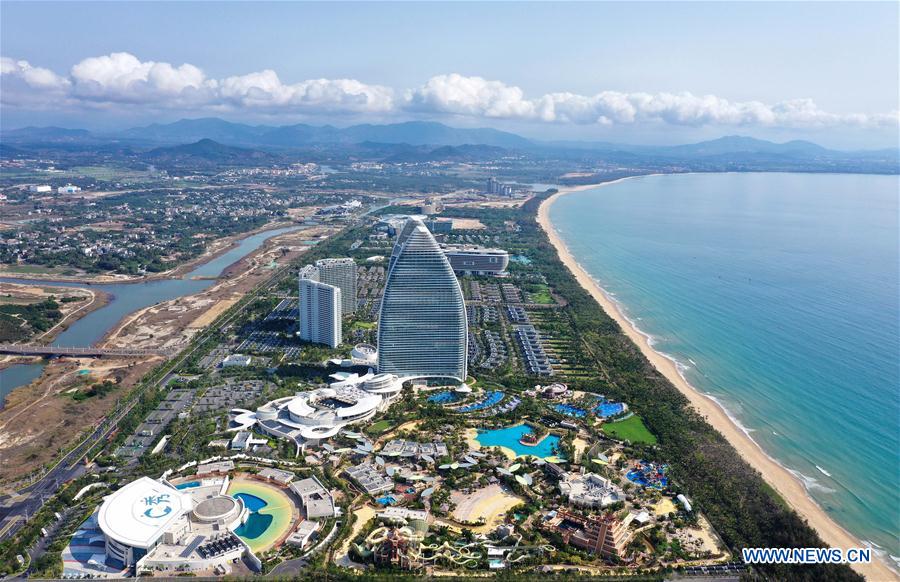Hainan: A new model of sustainable development
- By Mathew Wong
 0 Comment(s)
0 Comment(s) Print
Print E-mail China.org.cn, April 11, 2021
E-mail China.org.cn, April 11, 2021

Hainan, often referred to as China's Hawaii, is a tropical island off the southern coast of China. Covering 35,000 sq km and home to around 9.3 million people, it is a popular destination for Chinese tourists given its warm climate, clean environment, sandy beaches and beautiful scenery. Under China's reform and opening-up practice beginning in 1978, the island was designated as one of the country's first special economic zones a decade later in 1988. With a relatively small industrial sector, its economy has long relied on natural resources and the provision of services.
The Chinese government has demonstrated its determined and strategic goal of turning this largest special economic zone in China into a frontline integrating with the global economic system. After a series of planning discussions, on June 1, 2020, China announced a large-scale plan to turn the island into a globally significant free trade port by 2050. This is the country's 12th free trade port but the very first to cover an entire province, which allows it to maintain its economic strength and hence its national strength, and play a crucial role in the global economy.
Hainan's unique geographic location also helps it stand out among the many Chinese provinces. The island's proximity to the Pearl River Delta region as well as some South and Southeast Asian countries allows it to function as a crucial connector and facilitator on the Maritime Silk Road under the Belt and Road Initiative as well as development of the Greater Bay Area. Therefore, it is clear that China is attempting to make its development more coordinated and coherent.
According to the Chinese government, a series of business-friendly supporting policies and initiatives will be rolled out in several stages, as will corresponding changes to the tax and legal systems. It is hoped that zero tariffs, simple and low tax regimes, as well as robust legal institutions will help attain its goals. As a self-contained island, Hainan offers a distinctive testing space for aspiring planners to experiment with various new pilot policies and initiatives.
Given the aforementioned favorable conditions when compared to other existing pilot free trade zones, it is hoped that more foreign enterprises and investors – as well as highly educated and skilled talents – will flow into Hainan. This is aligned with China's overarching goal of accelerating economic restructuring and transforming its economic drivers. It is believed that innovation, quality and brands are more sustainable directions for growth.
Meanwhile, in order to tackle the challenges of losing its competitive edge due to labor shortages and increasing labor costs, this also reflects attempts by the Chinese government to move itself up the value-added chain using innovation. It is no longer possible to merely rely on labor-intensive manufacturing industries to generate economic growth. By re-establishing itself as a global center of innovation and technology, Hainan can help ensure its long-term productivity and competitiveness, especially when the high-value added output might offset the surge in labor costs.
The Chinese government's further development of Hainan is not arbitrary. The government deems the island's current solid foundation as something that allows it to develop in a more cost-effective manner. At present, Hainan's economy features various traditional service industries like finance, logistics and tourism, which have immense potential for expansion. Meanwhile, the scope of modern services could be further extended to include education, medicine, telecommunications, as well as science and technology, which could enhance economic development.
Another implication of Hainan's development is the shift from export-led growth to domestic consumption-based growth. In order to reduce reliance on exports and diversify risks when there are fluctuations within the global economy, the Chinese government is seeking to boost growth from domestic consumption at the same time. The potential development in a wide range of areas in Hainan will help spur consumption and economic growth by creating a new consumer base and expanding the middle class. Meanwhile, the expansion of private consumption in products and services will generate more employment opportunities in the long run.
Nonetheless, although the plan for developing Hainan seems to offer a promising breakthrough in China's economic development, there are still some limitations and uncertainties ahead in terms of the exact implementation, given the global COVID-19 situation. In the future, the Chinese government needs to offer more top-down strategic directions as well as concrete support to facilitate the development.
As the second largest economy in the world, China's economic performance will affect global economic development, especially as the entire world becomes more interconnected and interdependent. After all, the global economy benefits from sustainable growth in China. Hainan's model of sustainable development might also show other Chinese provinces how to achieve both quality and efficiency amid the economic slowdown.
Mathew Wong is an assistant professor in the Department of Social Sciences at the Education University of Hong Kong.
Opinion articles reflect the views of their authors, not necessarily those of China.org.cn.
If you would like to contribute, please contact us at opinion@china.org.cn.






Go to Forum >>0 Comment(s)